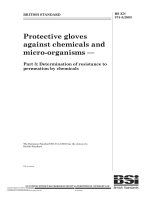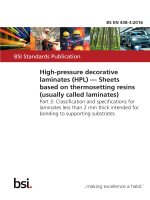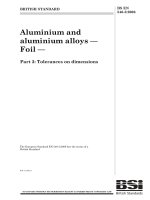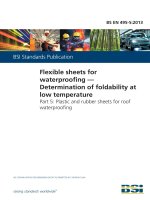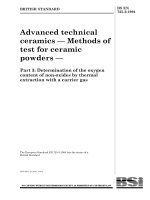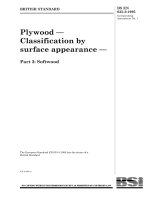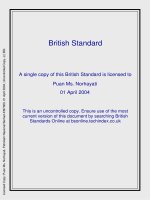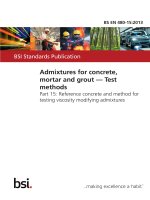Bsi bs en 01866 3 2013
Bạn đang xem bản rút gọn của tài liệu. Xem và tải ngay bản đầy đủ của tài liệu tại đây (945.75 KB, 18 trang )
BS EN 1866-3:2013
BSI Standards Publication
Mobile fire extinguishers
Part 3: Requirements for the assembly,
construction and pressure resistance of
CO2 extinguishers which comply with
the requirements of EN 1866-1
BS EN 1866-3:2013
BRITISH STANDARD
National foreword
This British Standard is the UK implementation of EN 1866-3:2013. Together
with BS EN 1866-1:2007 and BS EN 1866-2 it supersedes BS EN 1866:2005,
which will be withdrawn upon publication of BS EN 1866-2.
The UK participation in its preparation was entrusted to Technical
Committee FSH/2, Fire extinguishers.
A list of organizations represented on this committee can be obtained on
request to its secretary.
This publication does not purport to include all the necessary provisions of a
contract. Users are responsible for its correct application.
© The British Standards Institution 2013.
Published by BSI Standards Limited 2013
ISBN 978 0 580 79689 0
ICS 13.220.10
Compliance with a British Standard cannot confer immunity from
legal obligations.
This British Standard was published under the authority of the Standards
Policy and Strategy Committee on 30 September 2013.
Amendments/corrigenda issued since publication
Date
Text affected
BS EN 1866-3:2013
EN 1866-3
EUROPEAN STANDARD
NORME EUROPÉENNE
EUROPÄISCHE NORM
May 2013
ICS 13.220.10
Supersedes EN 1866:2005
English Version
Mobile fire extinguishers - Part 3: Requirements for the
assembly, construction and pressure resistance of CO2
extinguishers which comply with the requirements of EN 1866-1
Extincteurs d'incendie mobiles - Partie 3: Exigences
relatives au montage, à la construction et à la résistance à
la pression des extincteurs au dioxyde de carbone
conformes aux exigences de l'EN 1866-1
Fahrbare Feuerlöscher - Teil 3: Anforderungen an die
Herstellung, konstruktive Ausführung und Druckfestigkeit
von Kohlendioxid-Feuerlöschern, die den Anforderungen
von EN 1866-1 entsprechen
This European Standard was approved by CEN on 28 March 2013.
CEN members are bound to comply with the CEN/CENELEC Internal Regulations which stipulate the conditions for giving this European
Standard the status of a national standard without any alteration. Up-to-date lists and bibliographical references concerning such national
standards may be obtained on application to the CEN-CENELEC Management Centre or to any CEN member.
This European Standard exists in three official versions (English, French, German). A version in any other language made by translation
under the responsibility of a CEN member into its own language and notified to the CEN-CENELEC Management Centre has the same
status as the official versions.
CEN members are the national standards bodies of Austria, Belgium, Bulgaria, Croatia, Cyprus, Czech Republic, Denmark, Estonia,
Finland, Former Yugoslav Republic of Macedonia, France, Germany, Greece, Hungary, Iceland, Ireland, Italy, Latvia, Lithuania,
Luxembourg, Malta, Netherlands, Norway, Poland, Portugal, Romania, Slovakia, Slovenia, Spain, Sweden, Switzerland, Turkey and United
Kingdom.
EUROPEAN COMMITTEE FOR STANDARDIZATION
COMITÉ EUROPÉEN DE NORMALISATION
EUROPÄISCHES KOMITEE FÜR NORMUNG
Management Centre: Avenue Marnix 17, B-1000 Brussels
© 2013 CEN
All rights of exploitation in any form and by any means reserved
worldwide for CEN national Members.
Ref. No. EN 1866-3:2013: E
BS EN 1866-3:2013
EN 1866-3:2013 (E)
Contents
Page
Foreword..............................................................................................................................................................3
1
Scope ......................................................................................................................................................4
2
Normative references ............................................................................................................................4
3
Terms and definitions ...........................................................................................................................4
4
Symbols and abbreviated terms ..........................................................................................................5
5
Materials .................................................................................................................................................5
6
6.1
6.2
6.3
Design .....................................................................................................................................................6
General....................................................................................................................................................6
Cylinder subassembly...........................................................................................................................6
Hose assembly and attached components .........................................................................................6
7
7.1
7.2
7.3
Assembling and marking ......................................................................................................................7
General requirements............................................................................................................................7
Traceability .............................................................................................................................................7
Inspection and testing...........................................................................................................................8
Annex A (informative) Classification of the different parts of an extinguisher subject to internal
pressure..................................................................................................................................................9
Annex B (normative) Thread sizes for cylinder and valves of mobile CO2 extinguishers....................... 10
Annex C (normative) Test for burst pressure of hose assembly with attached components ................. 11
Annex D (informative) Filling ratios and pressures for CO2 ........................................................................ 12
Annex ZA (informative) Relationship between this European Standard and the essential
requirements of EU Directive 97/23/EC ............................................................................................ 13
Bibliography ..................................................................................................................................................... 14
2
BS EN 1866-3:2013
EN 1866-3:2013 (E)
Foreword
This document (EN 1866-3:2013) has been prepared by Technical Committee CEN/TC 70 “Manual means of
fire fighting equipment”, the secretariat of which is held by AFNOR.
This European Standard shall be given the status of a national standard, either by publication of an identical
text or by endorsement, at the latest by November 2013, and conflicting national standards shall be withdrawn
at the latest by November 2013.
Attention is drawn to the possibility that some of the elements of this document may be the subject of patent
rights. CEN [and/or CENELEC] shall not be held responsible for identifying any or all such patent rights.
This document, together with EN 1866-1 and EN 1866-2, supersedes EN 1866:2005.
This document has been prepared under a mandate given to CEN by the European Commission and the
European Free Trade Association, and supports essential requirements of EU Directive(s).
For relationship with EU Directive(s), see informative Annex ZA, which is an integral part of this document.
This standard EN 1866 consists of the following parts under the general title, Mobile fire extinguishers:
Part 1: Characteristics, performance and test methods
Part 2: Requirements for the construction, pressure resistance and mechanical tests for extinguishers,
with a maximum allowable pressure equal to or lower than 30 bar, which comply with the requirements
of EN 1866-1
Part 3: Requirements for the assembly, construction and pressure resistance of CO2 extinguishers which
comply with the requirements of EN 1866-1
According to the CEN-CENELEC Internal Regulations, the national standards organisations of the following
countries are bound to implement this European Standard: Austria, Belgium, Bulgaria, Croatia, Cyprus, Czech
Republic, Denmark, Estonia, Finland, Former Yugoslav Republic of Macedonia, France, Germany, Greece,
Hungary, Iceland, Ireland, Italy, Latvia, Lithuania, Luxembourg, Malta, Netherlands, Norway, Poland, Portugal,
Romania, Slovakia, Slovenia, Spain, Sweden, Switzerland, Turkey and the United Kingdom.
3
BS EN 1866-3:2013
EN 1866-3:2013 (E)
1
Scope
This European Standard specifies the rules of design, assembling, testing and inspection during
manufacturing of mobile CO2 fire extinguishers, which comply with the requirements of EN 1866-1, as far as
pressure resistance is concerned.
NOTE 1 Design is limited to design of the assembly.
NOTE 2
2
The classification of the different parts forming the assembly is given in Annex A.
Normative references
The following documents, in whole or in part, are normatively referenced in this document and are
indispensable for its application. For dated references, only the edition cited applies. For undated references,
the latest edition of the referenced document (including any amendments) applies.
EN 1866-1, Mobile fire extinguishers — Part 1: Characteristics, performance and test methods
EN ISO 4126-2, Safety devices for protection against excessive pressure — Part 2: Bursting disc safety
devices (ISO 4126-2)
EN ISO 10297, Transportable gas cylinders — Cylinder valves — Specification and type testing
(ISO 10297)
EN ISO 11363-1, Gas cylinders — 17E and 25E taper threads for connection of valves to gas cylinders —
Part 1: Specifications (ISO 11363-1)
EN ISO 15245-1, Gas cylinders — Parallel threads for connection of valves to gas cylinders —
Part 1: Specification (ISO 15245-1)
3
Terms and definitions
For the purposes of this document, the following terms and definitions apply.
3.1
mobile fire extinguisher
portable fire extinguisher with a total mass > 20 kg, fitted with wheels to enable the user to manually move
and operate the extinguisher
3.2
pressure at maximum operating temperature
pressure experimentally measured
PTmax
pressure measured in the extinguisher after stabilisation during at least 24 h at maximum operating
temperature Tmax (≥ 60 °C)
3.3
maximum allowable pressure
maximum declared pressure
PS
maximum pressure for which the equipment is designed, as specified by the manufacturer and which is in any
case greater than or equal to PTmax
3.4
cylinder valve
component subject to the internal pressure and used to close off and seal the cylinder
4
BS EN 1866-3:2013
EN 1866-3:2013 (E)
3.5
cylinder subassembly
subassembly consisting of a cylinder and a cylinder valve with integrated bursting disc
3.6
fire extinguisher assembly
an assembly of the cylinder subassembly or subassemblies, manifold, if required, hose and discharge valve
3.7
discharge valve
valve fitted at the end of the discharge hose, intended to regulate or temporarily stop the discharge of
extinguishing agent
3.8
bursting pressure
Pr
maximum pressure measured during a bursting test
3.9
Tmax
maximum operating temperature declared by the manufacturer
3.10
Tmin
minimum operating temperature declared by the manufacturer
4
Symbols and abbreviated terms
For the purposes of this document, the following symbols and abbreviated terms apply:
PS
maximum allowable pressure in bars
PT
test pressure in bars
Pr
bursting pressure in bars
Tmax maximum operating temperature, in °C
PTmax pressure at maximum operating temperature, in bars
Tmin minimum operating temperature, in °C
5
Materials
Non-metallic materials are not permitted by this standard for:
bodies;
bodies of cylinder valves;
bodies of operating valves;
hose couplings.
Materials of components that may be in contact with the contents shall be compatible with both the contents
and the material of other components.
5
BS EN 1866-3:2013
EN 1866-3:2013 (E)
6
Design
6.1 General
6.1.1
Introduction
A wheeled CO2 extinguisher is an assembly of the following pressure parts:
extinguishing agent cylinder subassembly or subassemblies with cylinder and cylinder valve;
hose assembly and attached components.
It is important that the cylinder subassembly should fulfil the requirements of the Transportable Pressure
Equipment Directive and bear the PI-marking.
6.1.2
Filling ratio
There is a relationship between the filling ratio, the maximum allowable pressure and the maximum allowable
temperature depending on the pressure-temperature curves of carbon dioxide. Commonly used filling ratios
are 0,667, 0,675 and 0,750. For these filling ratios, the corresponding pressures at 60 °C (PTmax) are shown
in Annex D.
The maximum allowable pressure PS of the extinguisher assembly shall be equal to or higher than PTmax and
shall not exceed the maximum allowable pressure PS of any component of the extinguisher assembly.
6.2
Cylinder subassembly
6.2.1
Cylinder
6.2.1.1
It is important that cylinders should fulfil the requirements of the Directive 2010/35/EU (TPED)
and bear the PI-marking.
6.2.1.2
Cylinders shall be suitable for the chosen filling ratio.
6.2.1.3
The thread of the cylinder shall be corresponding with the thread of the cylinder valve. This thread
shall be in accordance with the thread code as indicated in Annex B and shall be marked on the cylinder.
6.2.2
Cylinder valve
6.2.2.1
It is important that cylinder valves should fulfil the requirements of the Directive 2010/35/EU
(TPED) and bear the PI-marking.
6.2.2.2
Cylinder valves shall be submitted to the impact test in accordance with EN ISO 10297.
6.2.2.3
The thread of the cylinder valve shall be corresponding with the thread of the cylinder. This thread
shall be in accordance with the thread code as indicated in Annex B and shall be marked on the valve.
6.2.2.4
The cylinder valve shall be fitted with an integrated bursting disc device to provide a controlled
discharge of the contents of the extinguisher in case of overfilling and/or excessive ambient temperatures, e.g
in case of a fire. The bursting disc device shall comply with EN ISO 4126-2.
6.3 Hose assembly and attached components
6.3.1
Requirements
The hose assembly and attached components shall function throughout the operating temperature range, and
coupling systems shall be designed and fitted in such a way that they cannot damage the hose.
6
BS EN 1866-3:2013
EN 1866-3:2013 (E)
6.3.2
Prototype testing
When tested in accordance with Annex C, the bursting pressure Pr of the hose shall conform to:
three times the maximum allowable pressure PS, the test being carried out at (20 ± 5) °C, and;
twice P(Tmax), the test being carried out at (Tmax ± 2) °C and at (Tmin ± 2) °C.
7
Assembling and marking
7.1 General requirements
The manufacturer shall ensure that they have available the manufacturing means and processes suitable for
the assembly of the extinguisher in accordance with this standard.
The manufacturer shall ensure that the materials and components used in the fabrication of the body are free
from any defect likely to impair the safe use of the extinguisher.
The compatibility between the thread of the cylinder and the thread of the cylinder valve shall be checked.
The manufacturer's declared torque between the cylinder valve and the cylinder and the valve and the
bursting disc device shall be utilised.
Manufacturing processes shall be defined and controlled and shall not adversely affect the materials and
components of the extinguisher.
7.2 Traceability
7.2.1
Pressure retaining parts
The identification and the control of the materials for all pressure retaining parts shall be such as to ensure
that the materials used in manufacture meet the specification of the design.
Adequate procedures internal to the manufacturer, such as batch control, shall be applied.
7.2.2
Cylinder valves and hose assemblies
The cylinder valves and hose assemblies, which are or may be subjected to pressure during normal use, shall
be indelibly marked to permit subsequent identification and traceability.
The thread code shall be marked on the cylinder valve according to Annex B.
7.2.3
7.2.3.1
Marking
Cylinder valve
The cylinder valve shall be marked with:
the thread code according to Annex B;
PI mark including applicable associated markings.
7.2.3.2
Cylinder
The cylinder shall be marked with:
the thread code according to Annex B;
7
BS EN 1866-3:2013
EN 1866-3:2013 (E)
PI mark including applicable associated markings.
7.2.3.3
Extinguisher assembly
The extinguisher assembly shall be marked with:
mark of the extinguisher manufacturer as registered, for identification;
serial or batch number of the extinguisher;
year of manufacture of the extinguisher, represented by four digits, e.g. 2013;
tare in kg, including permanently attached accessories (necessary for refilling);
maximum filling mass – kg;
contained gas;
operating temperature range of the extinguisher assembly (Tmin/Tmax);
maximum allowable pressure PS.
The markings specified above shall be permanently marked.
NOTE
Marking requirements for the complete extinguisher are specified in EN 1866-1.
7.3 Inspection and testing
7.3.1
Cylinders and valves
Prior to assembly, it is important that the manufacturer should ensure that the cylinders and cylinder valves
have fulfilled the requirements of the Directive 2010/35/EU (TPED) and bear the PI marking. The
manufacturer shall keep record of all relevant certificates.
The cylinders and valves shall be pressure tested prior to assembly, because a hydrostatic test after assembly
would be harmful.
7.3.2
Hose assemblies
Prior to assembly, the manufacturer shall ensure that the hose assemblies have been tested for resistance to
test pressure.
The hydrostatic test pressure PT shall not be less than 1,43 times the allowable pressure PS. The test
pressure shall be maintained for a minimum of 30 s; no leakage or permanent deformation shall occur.
The manufacturer shall keep record of all test certificates.
7.3.3
Final inspection
The content of the extinguisher shall be checked by weighing to ensure it is filled in accordance with the filling
tolerances specified in EN 1866-1 and in the approved design of the extinguisher.
After complete assembly of the mobile extinguisher, a final inspection shall be carried out to ensure that all
parts comply with the approved design of the extinguisher and manufacturing records and that the assembly
was carried out correctly.
8
BS EN 1866-3:2013
EN 1866-3:2013 (E)
Annex A
(informative)
Classification of the different parts of an extinguisher subject to internal
pressure
In the framework of "Pressure Equipment Directive" the different parts under pressure forming the assembly of
an extinguisher can be classified as indicated in Table A.1.
Table A.1 — Classification
Part
Type of equipment
Category
Table from Annex II
Hose
Piping
Art. 3 § 3 or category I in function of DN
Table 7
Hose assembly and
attached components
Pressure accessory
Art. 3 § 3 or category I in function of DN
Table 7
Discharge valve
Pressure accessory
Art. 3 § 3 or category I in function of DN
Table 7
9
BS EN 1866-3:2013
EN 1866-3:2013 (E)
Annex B
(normative)
Thread sizes for cylinder and valves of mobile CO2 extinguishers
NOTE
See 7.2.3.
Table B.1 — Thread code
Thread code
Standard
M25
25E
EN ISO 15245-1
EN ISO 11363-1
The thread code shall be stamped, engraved or embossed on the cylinder and the valves.
10
BS EN 1866-3:2013
EN 1866-3:2013 (E)
Annex C
(normative)
Test for burst pressure of hose assembly with attached components
NOTE
See 6.3.
Where testing is to be carried out at a temperature other than 20 °C, condition the hose and attached
components at the relevant temperature for a period of between 12 h and 24 h.
The hose and attached components shall be fitted to a means of providing the required pressure and the open
end blanked off by suitable means.
Increase the pressure in the hose and attached components to the minimum applicable value as specified in
6.3.2 in a time of not less than 30 s and maintain the pressure for a further 30 s. If the hose and attached
components do not burst, increase the pressure until the hose and/or attached components do burst and
record the pressure at which it occurs.
11
BS EN 1866-3:2013
EN 1866-3:2013 (E)
Annex D
(informative)
Filling ratios and pressures for CO2
NOTE
See 6.1.2.
Table D.1 — Filling ratios and pressures
12
Filling Ratio
Tmax
PTmax
kg/l
°C
Bar
0,667
60
169,3
0,675
60
173,8
0,750
60
216,1
BS EN 1866-3:2013
EN 1866-3:2013 (E)
Annex ZA
(informative)
Relationship between this European Standard and the essential
requirements of EU Directive 97/23/EC
This European Standard has been prepared under a mandate given to CEN by the European Commission
and the European Free Trade Association to provide a means of conforming to Essential Requirements of the
New Approach Directive 97/23/CE.
Once this standard is cited in the Official Journal of the European Union under that Directive and has been
implemented as a national standard in at least one Member State, compliance with the clauses of this
standard given in Table ZA.1 confers, within the limits of the scope of this standard, a presumption of
conformity with the corresponding Essential Requirements of that Directive and associated EFTA regulations.
Table ZA.1 — Correspondence between this European Standard and Directive 97/23/EC
Clauses in EN 1866-3
Essential requirements
of Directive 97/23/EC
Qualifying remarks/Notes
6.1, 6.2, 6.3
2.8
Assemblies
6.1, 6.2.1.2, 6.2.1.3, 6.2.2.2, 6.2.2.3, 6.3
2.3
Safe handling and operation
7.2
3.1.5
Traceability
7.3
3.2.1
Final inspection
7.3.2
3.2.2
Proof test
7.2
3.3a
Marking and labelling
7.3.2
7.4
Hydrostatic test pressure
WARNING — Other requirements and other EU Directives may be applicable to the product(s) falling within
the scope of this standard.
13
BS EN 1866-3:2013
EN 1866-3:2013 (E)
Bibliography
[1] Directive 2010/35/EU of the European Parliament and of the Council of 16 June 2010 on transportable
pressure equipment (TPED) and repealing Council Directives 76/767/EEC, 84/525/EEC, 84/526/EEC,
84/527/EEC and 1999/36/EC
14
This page deliberately left blank
NO COPYING WITHOUT BSI PERMISSION EXCEPT AS PERMITTED BY COPYRIGHT LAW
British Standards Institution (BSI)
BSI is the national body responsible for preparing British Standards and other
standards-related publications, information and services.
BSI is incorporated by Royal Charter. British Standards and other standardization
products are published by BSI Standards Limited.
About us
Revisions
We bring together business, industry, government, consumers, innovators
and others to shape their combined experience and expertise into standards
-based solutions.
Our British Standards and other publications are updated by amendment or revision.
The knowledge embodied in our standards has been carefully assembled in
a dependable format and refined through our open consultation process.
Organizations of all sizes and across all sectors choose standards to help
them achieve their goals.
Information on standards
We can provide you with the knowledge that your organization needs
to succeed. Find out more about British Standards by visiting our website at
bsigroup.com/standards or contacting our Customer Services team or
Knowledge Centre.
Buying standards
You can buy and download PDF versions of BSI publications, including British
and adopted European and international standards, through our website at
bsigroup.com/shop, where hard copies can also be purchased.
If you need international and foreign standards from other Standards Development
Organizations, hard copies can be ordered from our Customer Services team.
Subscriptions
Our range of subscription services are designed to make using standards
easier for you. For further information on our subscription products go to
bsigroup.com/subscriptions.
With British Standards Online (BSOL) you’ll have instant access to over 55,000
British and adopted European and international standards from your desktop.
It’s available 24/7 and is refreshed daily so you’ll always be up to date.
You can keep in touch with standards developments and receive substantial
discounts on the purchase price of standards, both in single copy and subscription
format, by becoming a BSI Subscribing Member.
PLUS is an updating service exclusive to BSI Subscribing Members. You will
automatically receive the latest hard copy of your standards when they’re
revised or replaced.
To find out more about becoming a BSI Subscribing Member and the benefits
of membership, please visit bsigroup.com/shop.
With a Multi-User Network Licence (MUNL) you are able to host standards
publications on your intranet. Licences can cover as few or as many users as you
wish. With updates supplied as soon as they’re available, you can be sure your
documentation is current. For further information, email
BSI Group Headquarters
389 Chiswick High Road London W4 4AL UK
We continually improve the quality of our products and services to benefit your
business. If you find an inaccuracy or ambiguity within a British Standard or other
BSI publication please inform the Knowledge Centre.
Copyright
All the data, software and documentation set out in all British Standards and
other BSI publications are the property of and copyrighted by BSI, or some person
or entity that owns copyright in the information used (such as the international
standardization bodies) and has formally licensed such information to BSI for
commercial publication and use. Except as permitted under the Copyright, Designs
and Patents Act 1988 no extract may be reproduced, stored in a retrieval system
or transmitted in any form or by any means – electronic, photocopying, recording
or otherwise – without prior written permission from BSI. Details and advice can
be obtained from the Copyright & Licensing Department.
Useful Contacts:
Customer Services
Tel: +44 845 086 9001
Email (orders):
Email (enquiries):
Subscriptions
Tel: +44 845 086 9001
Email:
Knowledge Centre
Tel: +44 20 8996 7004
Email:
Copyright & Licensing
Tel: +44 20 8996 7070
Email:
